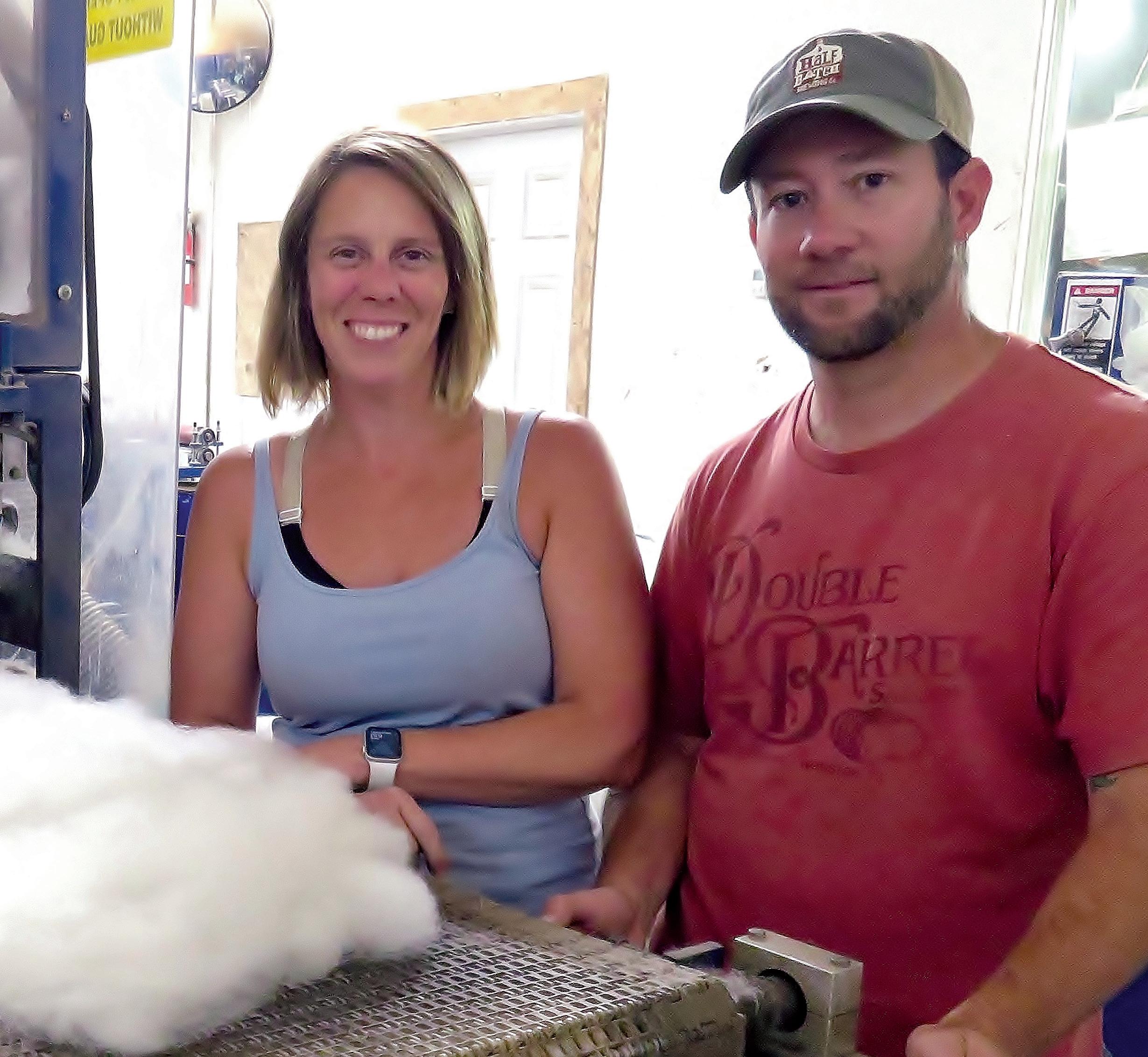
8 minute read
CO-OP PEOPLE

“Right now, what we’re doing is a voluntary effort to introduce more renewable energy to our portfolio in a way that doesn’t increase overall costs, but still satisfies the demand we have from some members who want to have more renewable energy in their supply,” says Craig Grooms, Buckeye Power’s vice president of engineering and operations.
When energy enters the electric grid, there’s no way to distinguish solar energy from that generated by coal. Electric providers can’t send solar-generated electrons to one member’s house and those generated by coal to another.
“It’s essentially a matter of energy accounting,” Grooms says. “We put energy on the grid, measure it, and get paid for it. Consumers use electricity from the grid, have a meter that measures it, and they’re charged for that amount. In that equation, you can’t tell where it comes from.”
What providers like Buckeye Power can do, however, is to adjust the percentage of energy from different sources that’s put out onto the grid — when the sun is shining, for example, more can come from solar panels; when it’s dark or cloudy, more must come from coal.
As opposed to individually purchased rooftop panels, which require a substantial up-front investment from a consumer — an investment that usually is financed at payments much larger than most electric bills — the OurSolar program lets consumer-members pay a small premium on their electric bill to assure that a larger percentage of energy on the grid comes from solar panels.
“OurSolar opens the benefits of solar generation to anyone who receives an electric bill, including lowerincome residents, businesses, municipalities, schools, and nonprofits,” says Pat O’Loughlin, president and CEO of Buckeye Power. “It gives members a lower-cost, more convenient option, compared to on-site solar.”
The subscription question
Individual cooperatives offer the opportunity for their members to participate in the OurSolar program in different ways. Some offer subscriptions that can be purchased by individual members, others provide it as a resource to all members. There’s no clear-cut “best” way to increase solar energy production; those decisions — like all co-op decisions — are made by local boards and management on behalf of and in the best interests of the membership.
Ultimately, the program reflects the cooperatives’ dedication to their most important objective.
“Ohio’s electric cooperatives will not waiver from our mission to supply affordable, reliable, and environmentally responsible power to our members,” O’Loughlin says. “Our decisions regarding the generation sources and the integration of renewable energy now and into the future can’t consider only one or two of those objectives; they have to meet all three.”
Percentage of Buckeye Power’s renewable generation from various sources
Ohio’s co-ops take a balanced approach to renewable energy. While continuing to support and utilize affordable coal-fired generation for the bulk of their power, Buckeye Power and its member cooperatives have made significant investments in renewable energy on behalf of Ohio co-op families.
75.2% Hydropower 55 MW
13.1% Landfill gas 9.6 MW
*Upon completion of OurSolar Phase 2 next summer



































CO-OP PEOPLE
Robbie and Carrie Davis have built a solid business out of fleecing their customers. Spinning yarns

STORY AND PHOTOS BY DAMAINE VONADA
When a young woman approached Robbie and Carrie Davis about making the yarn for her wedding shawl, they readily obliged. The brideto-be wanted the yarn to contain fleece from a specific alpaca, so they created an alpaca-silk blend especially for her. “She’ll use our yarn to weave the shawl herself and eventually will pass it on as a family heirloom,” says Carrie. “That just gives me chills.”
Robbie and Carrie are Butler Rural Electric Cooperative members who operate a fiber mill — America’s Natural Fiberworks (ANF) — at Blessed Criations, the 11-acre farm near Oxford where they also make their home.
A cria is a baby alpaca, and the farm’s name was inspired by the couple’s years of alpaca industry experience. They acquired their first alpacas in 2006 and soon began breeding and showing the animals at fairs with help from their son, Jessie, who is now 20 and an aviation technology student at Sinclair Community College. Alpacas don’t shed, so Robbie and Carrie became adept at shearing.
Soon, breeders began to hire them to shear, and the couple noticed that shaved fleece was usually discarded. They opened the mill in 2012 to convert raw alpaca fiber into yarn or felt. Carrie learned to card and spin by hand, and Robbie, who had been an ironworker for 20 years, quit his job to tend their fledgling cottage industry. As word about the mill spread and orders increased, they wanted to expand, but banks balked at lending money to a mill. That’s when Kim and Brad DeLaney, of Ohio’s KB
Left, Carrie and Robbie Davis in their fiber mill at Blessed Criations Farm near Oxford; right, a close-up look at some of their alpaca-shorn yarns. Alpacas, invested in ANF and helped the Davises purchase equipment. “We originally thought we could get harvested fiber from within a 50-mile radius,” says Robbie. “Now we have customers in 42 states, including Alaska and Hawaii.”

Because of ANF’s success, Robbie and Carrie reduced the size of Blessed Criations’ herd. “We decided that if we couldn’t give 100% to our alpacas, we shouldn’t be breeding and selling them,” says Carrie. The couple still owns or co-owns animals being raised at KB Alpacas and other breeding farms. The Davises outfitted ANF with equipment manufactured by Belfast Mini Mills, a Canadian company specializing in machinery for processing small batches of fiber. Because of difficulties finding and keeping employees, Robbie and Carrie run the mill themselves and have upped their productivity by doubling its equipment. “We have two of everything except for the washer and the picker,” says Robbie. He and Carrie process about 7,500 pounds of fiber annually. “That’s a lot for two people,” notes Robbie. “We’ve been told that the next-highestproducing mini-mill is in Tennessee and does 4,000 pounds a year with full-time help.” Robbie estimates that the United States has about 125 mini-mills. “Around 50% of them are full-service mills like ANF,” he says, “and the rest are limited to making things like rug yarn.” Besides two- and three-ply yarns, Robbie and Carrie turn out roving, batting, rug yarn, felt, and lopi, a very long, single-strand yarn made from Icelandic sheep wool. They also do small weaving projects, create rugs, and dye yarns for customers. “We just made scarlet and gray yarn for someone who wanted Ohio State’s colors,” says Carrie. Though they focus on alpaca fleece, the Davises will give any natural fiber a whirl and have processed hair from bison, yak, goats, rabbits, cats, and dogs. “What differentiates us,” says Carrie, “is that we’ll do fiber from individual animals. Sometimes people even ask us to put a card with an animal’s picture on a finished skein of yarn.” Robbie and Carrie work with 250 to 300 customers every year. “The majority are repeats,” says Robbie. “Most are small alpaca farms or individuals, like the lady who buys fleece and pays us to turn it into yarn that she sells online.” Taking great pride in the mill, the Davises love it when people send them photos of items made with ANF yarn, and for them, that strong fabric of relationships is a source of satisfaction that more than compensates for the constantly clattering machinery, long hours on their feet, and late nights spent washing fleece. The quality of their work got a big pat on the back when a well-known breeding farm in Colorado recently chose ANF to make yarn from its prize alpaca’s fleece. “We were super excited to get fleece from the top animal of a top breeder,” says Carrie, “and the fact that they trusted us with it is something that feels really good.” America’s Natural Fiberworks: email blessedcriations@yahoo.com or visit www.americasnaturalfiberworks.com.


